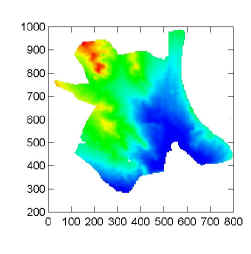
Topography

Our study site consists of adobe hills and washes (for pictures see here). Here you see the topographic pattern at the site (red is high elevation, blue is low). The scale is in meters. There are a series of hills (about seven of them) on, or immediately adjacent to the study site. The importance of the hills is that, on their mating flight, males ants fly to the tops of hills, emitting pheromones to attract females and starting large mating swarms. The dispersing females then come from the hilltops. The most important hill for mating is just off of the study site (at about 750, 780) on the map.
The
nearest National Weather Service station is in
The topography also influences the vegetation at the site. Check here for the vegetation effects.